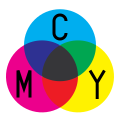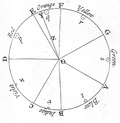Complementary color
Complementary colors are pairs of opposite colors. What is meant by opposite can be different between color science, art, and printing.
Color science
In color science, "complementary colors" are colors opposite to each other on the color wheel. Primary colors and secondary colors are paired in this way:
- red and cyan ( red cyan ), where cyan is the mixture of green and blue
- green and magenta ( green magenta ), where magenta is the mixture of red and blue
- blue and yellow ( blue yellow ), where yellow is the mixture of red and green
Along with these pairs, there is another pair of complementary colors: the basic color and the tertiary color made by mixing two other complementary colors.
Afterimages
If a person stares at a single color for about a minute then looks at a white surface, an afterimage of the complementary color will appear. This is because of eye fatigue.[1] For example, if the person stares at a red color, the photoreceptors (cells in the eye which catch colored light) for red light in the retina (the back part of the eye) become fatigued. When photoreceptors are fatigued, they are less able to send information to the brain. If the person then looks at white light, all photoreceptors will send information. Because the photoreceptors for red light are fatigued, the information they send will not be as strong as the information about the other colors, and the illusion of seeing the complementary color, cyan, is made.
Art and design

Because of the limited range of colors that was available throughout most of the history of art, many artists still use a traditional set of complementary pairs, including:
The complement of each primary color (red, blue, or yellow) is roughly the color made by mixing the other two in a subtractive system (red + blue = purple; blue + yellow = green; red + yellow = orange). When two complements are mixed, they produce a gray or brown.
The use of complementary colors is an important aspect of art and graphic design. This also extends to other fields such as contrasting colors in logos and retail display. When placed next to each other, complements make each other appear brighter. On an artistic color wheel, complementary colors are placed opposite one another. Although these artistic complements are not complements under the scientific definition, most artistic color wheels are laid out roughly like the HSV color wheel.
References
- ↑
Complementary Color Media
Complementary colors in the RGB and CMY color models
Complementary colors in the traditional RYB color model
Complementary colors in the opponent process theory.
A traditional color star developed in 1867 by Charles Blanc. The traditional complementary colors used by 19th-century artists such as Van Gogh, Monet and Renoir are directly opposite each other.
The colors of the RGB color model, which uses combinations of red, green, and blue light on a black screen to create all the colors seen on a computer display or television. Complementary colors are opposite each other.
"Color & The Absorption Spectrum". Archived from the original on February 23, 2007. Retrieved January 14, 2007.








